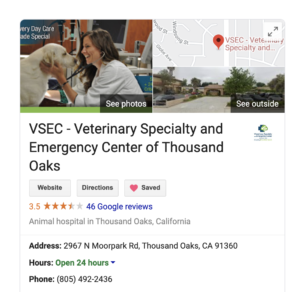What is SEO? And Why Should My Specialty/Referral Practice Care?
Reading Time: 4 minutes
Search Engine Optimization (SEO) is the art and science of increasing traffic to a website by strategically helping it rank as high as possible in online search results.
As a practice owner, veterinarian, specialist, hospital administrator, or team member, we hope you always care how your practice is found and perceived online. Even if 90% of your cases come from referrals.
It’s important to know that pet parents may conduct a quick online search of your hospital to ensure it is the ‘best fit’ for their pet after they have been referred. Or, their pet may have recently been diagnosed with a significant condition such as cancer or mitral valve dysplasia, and they go online looking for treatment options. Therefore, to ensure your practice or hospital is one of the top results in an online search, you need more than just a website. In addition to having a well-designed site, your hospital must be appropriately listed on Google Maps, have a Google My Business Profile, a Yelp profile (with a high rating), social media channels, and consistency of your practice’s name and information across of these online resources.
Why Do Search Engines Matter?
On Google alone, there over 5 billion searches a day. Consumers are utilizing search engines to find a service, research, and now, most commonly, ask a question. That is why it is essential to not only have the necessary information on your website (hours, services, team members, location) but also include the answers to the questions pet owners are searching for.
For example, an emergency and referral hospital can create a blog post, “Why is my dog vomiting?” where you provide several reasons why that may be happening and, most importantly, include a call-to-action (CTA), which is to seek medical attention or call the practice.
For a specialty hospital that offers oncology, add a section on the Services page that answers common questions about pet cancer care – Is chemotherapy safe? or Can cancer in pets be cured? Think of the questions clients ask in the exam room and start to develop content on your site that answers those.
The more information Google has, the better it can show your website to users looking for a service or information. Once people reach your website or blog post, the content should be compelling enough to direct them to take action. Your copy and calls to action must be strong and clear, so the visitor becomes a prospective client. You want them to not only consume the information but also pick up the phone, send an email, complete a pre-registration form – complete an action, known as a conversion. You want them to DO something.
Not All SEO is on Your Website
Local search is one of the top buzzwords in SEO. If a company sells goods or provides a service at a specific location, it can attract customers via local search, and yes, that includes the veterinary industry. Also, Google pulls information from sites like Yelp to appear in search results. That is why it is imperative to ensure your hospital or practice is listed correctly with the same information – address, hours, phone number, and company name on social media (Facebook, Instagram, LinkedIn), Yelp, Google My Business/Google Maps, etc.
The New Website Home page
Google My Business (GMB), a local listing directly through Google. It is vital to claim your practice on Google and complete the profile with a short “About” description, correct address, and photos of your practice. This platform allows users to view your hospital on search and Google Maps before they see your website in the results. GMB is often referred to as the new ‘home page’ for businesses as many web users get everything they need from this profile, including directions, phone number, view photos, and read reviews. This is another reason to ensure that the GMB profile is listed correctly and updated often.

So, Is SEO Free?
A great question! Yes and no. Content changes to your website and the optimization of local search directories and social media channels are often referred to as organic search (non-paid). While you might pay a staff member or an agency to manage and enhance organic search, your practice is not paying Google or another entity to utilize those tools. However, there is paid search – a form of digital advertising on a search engine.
Google Ads, also known as a cost-per-click (CPC) or pay-per-click (PPC), reach people exactly when they’re interested in the services the hospital provides.
Paid ads appear at the top of the Google search results page next to or under an “Ads” label. Ads are ranked primarily based on how relevant and useful they are to what the person searched for, budget, and a few other factors. Additionally, Google Ads can be displayed on Google Play, Google Shopping, and Google Maps.
Google Ads enables businesses to set a budget for advertising and only pay when users click the ads. The implementation of a well-developed and well-managed Google Ads strategy can help lead to increases in website traffic, calls, and even appointments.
However, paid SEO should be part, but not the only, online digital marketing tool your practice implements. The combination of an organic and paid SEO strategy can complement one another and ensure Google is providing the right information in search results.
We hope this has answered your questions and you are ready to get your practice on a well-established, thoughtful, and strategic SEO campaign. However, if you need some help, have questions, or feel overwhelmed, contact the digital marketing specialists here at BluePrints.